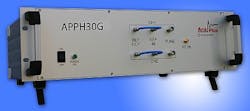Cross-correlation phase noise test system from AnaPico AG offered by distributor Saelig
FAIRPORT, N.Y., 8 March 2013. Electronics distributor Saelig Co. Inc. in Fairport, N.Y., is offering the APPH30G high-performance cross-correlation phase noise test system from AnaPico AG in Zurich, Switzerland.
The test & measurement instrument is for 5 MHz to 30 GHz frequencies for evaluating RF and microwave signal sources such as crystal oscillators, PLL synthesizers, clocks, phase-locked VCOs, and DROs.
The APPH30G measures single sideband residual and additive phase noise, amplitude noise, and baseband noise. The self-contained instrument with cross-correlator engine and internal low noise reference sources to enable one-click measurements of frequencies as high as 30 GHz.
The APPH30G offers measurement functions , etc. It provides phase and amplitude noise measurement, residual noise characterization, or direct access to the FFT analyzer for baseband signal and (LF) noise analysis.
Using cross-correlation measurement and self-calibration, the device obtains reproducible measurements even under changing environmental conditions. Automated frequency acquisition and self-calibration can simplify use.
The APPH30G is optionally available with LAN (VXI-11), USBTMC, or GPIB interfaces. A user interface, API library, and SCPI command language set is provided.
Measurements supported include additive or absolute phase noise measurement using internal or external references; amplitude noise measurements and other automated measurements for evaluating RF signal sources. SSB phase noise; amplitude noise; AM noise measurement; additive or residual noise characterization; and baseband noise measurements to 30 GHz.
Designed to operate from external 6-volt DC power at altitudes to 15,000 feet, the device operates in temperatures from zero to 45 degrees Celsius, and weighs nine pounds.
For more information contact Saelig online at www.saelig.com, or AnaPico at www.anapico.com.

